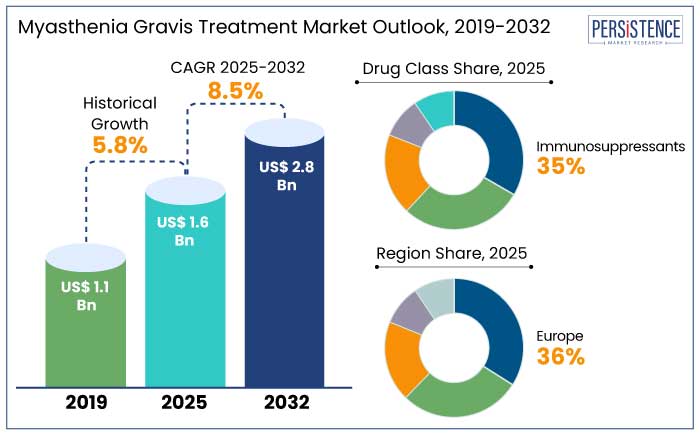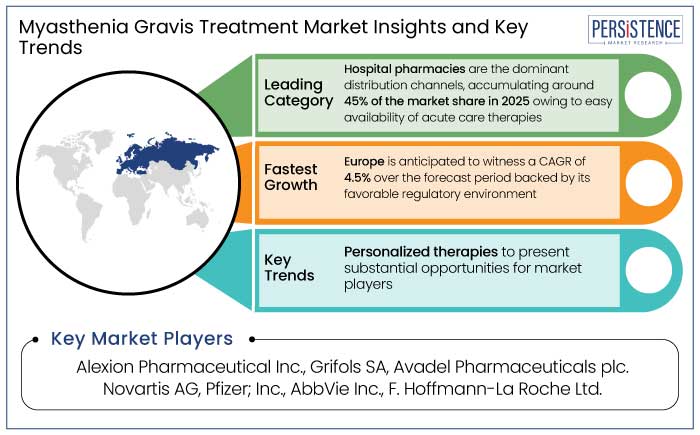Industry: Healthcare
Published Date: January-2025
Format: PPT*, PDF, EXCEL
Delivery Timelines: Contact Sales
Number of Pages: 184
Report ID: PMRREP33757
The myasthenia gravis treatment market is estimated to increase from US$ 1.6 Bn in 2025 to US$ 2.8 Bn by 2032. The market is projected to record a CAGR of 8.5% during the forecast period from 2025 to 2032.
The dynamic growth of the myasthenia gravis treatment industry is influenced by factors such as rising adoption of immunotherapies, approval of promising drugs, emergence of biologics, and increasing awareness of rare diseases. Medications like pyridostigmine enhance neuromuscular transmission and are commonly prescribed for symptom management.
They are part of the broader medication segment, which held a 71.8% share of the global market in 2023. Biologic therapies, such as eculizumab, offer targeted treatment options, and their surging adoption is set to drive market growth.

Key Highlights of the Market
|
Market Attributes |
Key Insights |
|
Myasthenia Gravis Treatment Market Size (2025E) |
US$ 1.6 Bn |
|
Projected Market Value (2032F) |
US$ 2.8 Bn |
|
Global Market Growth Rate (CAGR 2025 to 2032) |
8.5% |
|
Historical Market Growth Rate (CAGR 2019 to 2023) |
5.8% |
Europe is emerging as a key player in the myasthenia gravis treatment market, driven by its robust healthcare infrastructure and stringent regulatory framework. The region is home to a well-established healthcare system, which includes unique diagnostic tools and specialized treatment centers for neurological disorders. It is anticipated to hold a share of 36% in 2025 and witness a CAGR of 4.5% through 2032.
The European Medicines Agency (EMA) plays a pivotal role in facilitating the approval of innovative therapies, with a strong focus on bolstering treatments for conditions like myasthenia gravis. The agency's proactive stance on drug approvals and commitment to fostering therapeutic innovation create an environment conducive to the rapid adoption of novel MG treatments.
The region's regulatory environment is both stringent and supportive, ensuring the safety and efficacy of treatments. It protects patients and encourages investor confidence, making Europe an attractive destination for significant research and development initiatives. With surging prevalence of neurological conditions like myasthenia gravis in Europe, these efforts are anticipated to push market growth, making the region a dominant force in the global market.
Immunosuppressants are anticipated to hold a significant share of 35% in 2025. These drugs are crucial in treating myasthenia gravis, as these directly target the underlying cause of the disease.
Immunosuppressants suppress the immune system and reduce the production of antibodies that attack the neuromuscular junction, reducing muscle weakness and other symptoms. Common immunosuppressive drugs used in the treatment of MG include azathioprine, mycophenolate mofetil, and cyclophosphamide.
Immunosuppressants dominate the global market largely because these can provide long-term relief for patients by controlling disease progression. These drugs are particularly effective in patients who do not respond well to cholinesterase inhibitors or corticosteroids. Since immunosuppressants can be used as long-term therapy, these are often a primary treatment option for managing chronic MG, making these essential in neurological care.
Hospital pharmacies hold the most prominent share of 45% in the myasthenia gravis treatment industry in 2025. It is primarily because MG treatments, including immunosuppressants, biologic therapies, and acute care therapies like plasmapheresis and IVIG, are often administered in hospital settings.
Hospital pharmacies provide patients with easy access to specialized medications and personalized treatments essential for managing myasthenia gravis. These medications often require a prescription from specialists such as neurologists or immunologists, making hospitals the go-to place for comprehensive care.
MG patients mainly require more complex treatments closely monitored by healthcare professionals. These include plasma exchange or stem cell transplants, which are more readily available in hospitals.
Increasing number of hospital-based treatment programs for myasthenia gravis also fuels the dominance of hospital pharmacies. As the disease can cause severe symptoms and complications, patients often require urgent care and close medical supervision, which can only be effectively provided in hospital settings.
Increasing prevalence of MG, particularly among the aging population, is a significant driver, prompting increased research and development efforts. Innovations in biologics, such as developing novel monoclonal antibodies targeting specific immune components, present opportunities for more targeted and effective treatment options.
Rising focus on precision medicine and personalized treatment regimens tailored to individual patient profiles offers avenues for market growth. Collaborations between pharmaceutical companies and research institutions as well as a deeper understanding of MG's underlying mechanisms provide opportunities to innovate therapeutic approaches.
As the MG treatment landscape evolves, market players are poised to capitalize on these drivers. It is ultimately set to enhance the efficacy and accessibility of treatment options for individuals with myasthenia gravis.

Between 2019 and 2023, the myasthenia gravis treatment market showcased a CAGR of 5.8%. It was driven by innovations in targeted therapies and increasing diagnosis rates. Introduction of novel treatments, such as monoclonal antibodies and complement inhibitors, significantly enhanced therapeutic options for generalized myasthenia gravis (gMG).
Key players like UCB S.A., AstraZeneca, and others extended their product portfolios, contributing to market growth. Rising awareness of the disease and improved healthcare access further supported demand. During this period, the market witnessed a moderate CAGR, reflecting an increasing focus on addressing unmet medical needs in the MG patient population.
Immunosuppressive drugs like corticosteroids and immunomodulatory are employed to manage the autoimmune response. Therapies targeting specific immune pathways, such as monoclonal antibodies, are emerging as promising interventions.
The evolving landscape of MG treatment strives to enhance patient quality of life, minimize symptom severity, and achieve long-term remission. It is focusing on a multifaceted approach to address the complex pathophysiology of the disease.
Developments in Immunotherapies Set to Augment Demand
The myasthenia gravis treatment industry is experiencing significant growth, driven by developments in immunotherapies. Innovative treatment approaches, particularly the development of monoclonal antibodies targeting specific immune system components, have shown promising results in managing myasthenia gravis. These are designed to modulate immune responses, reducing the impact of autoantibodies on the neuromuscular junction, which is central to the progression of MG.
The approval and integration of ground-breaking immunotherapeutic agents like eculizumab and rituximab have marked a pivotal shift in the treatment of MG. These targeted therapies provide more precise and effective disease management, offering better outcomes for patients.
The continued evolution of immunotherapies is a critical driver shaping the MG treatment industry, equipping healthcare professionals with unique tools to address the complex immunological mechanisms underlying the disease. As the field of immunotherapy evolves, the market is positioned for sustained growth.
Rising Prevalence of Neurological Disorders to Spur Growth
Rising prevalence of neurological disorders, including myasthenia gravis, is a key growth driver for the market. The aging population and increasing incidence of autoimmune diseases globally contribute to the rising number of MG cases.
As the global population ages, diseases like MG, which is more common in older individuals, are set to rise. Environmental factors, such as pollution and lifestyle changes, have contributed to increasing incidence of autoimmune diseases, including MG. With these factors in mind, demand for effective treatments to manage and slow the progression of myasthenia gravis has escalated.
As the disease burden increases, demand for therapeutic interventions and the focus on developments in MG treatment are projected to rise. Healthcare systems are under greater pressure to provide specialized care, resulting in the development of more targeted treatment options and innovative therapies that will continue to propel the market forward.
Regulatory Challenges May Hamper Growth
One influential factor that could affect the myasthenia gravis treatment market is the complex landscape of regulatory challenges. As innovative treatments and therapeutic approaches emerge, regulatory bodies play a key role in assessing their safety, efficacy, and impact on patient outcomes.
The process of obtaining regulatory approvals for new drugs and treatments can be time-consuming and intricate, impacting the speed at which novel therapies can enter the market. The stringent regulatory environment poses a potential hurdle for companies striving to establish dominance in the market. Navigating these regulatory complexities effectively will likely be vital for industry players aiming to lead in a market shaped by developments in treatment options.
Personalized Therapies to Present Substantial Opportunities for Key Players
One of the lucrative opportunities for growth in the market lies in the exploration of personalized therapies. Tailoring treatment regimens based on individual patient profiles, including genetic factors and immune system dynamics, can enhance treatment efficacy and reduce adverse effects.
Developments in precision medicine allow for a more nuanced understanding of myasthenia gravis's heterogeneity, paving the way for targeted therapies that address specific disease manifestations. Companies investing in research and development to create personalized treatment approaches stand to not only improve patient outcomes but also differentiate themselves in a competitive market. It is ultimately driving revenue through the delivery of more effective and patient-centric myasthenia gravis treatments.
Exploring novel treatment modalities beyond traditional immunosuppressants and acetylcholinesterase inhibitors can unlock untapped market potential. Development of targeted biologics, gene therapies, and innovative immunomodulatory agents presents avenues for more effective and specific interventions.
Companies investing in the research and development of these novel treatment modalities position themselves at the forefront of therapeutic innovation. Diversifying the treatment arsenal not only addresses unmet medical needs but also creates new revenue streams in the dynamic and competitive myasthenia gravis treatment market.
Alexion Pharmaceutical Inc., Grifols SA, Avadel Pharmaceuticals plc., Novartis AG, and Pfizer Inc. are the prominent organizations in the market. Understanding competitors' research and development initiatives, clinical trial progress, and market positioning provides valuable insights.
Analyzing the success and challenges faced by key players in introducing novel treatments, such as monoclonal antibodies, aids in anticipating market trends. Scrutinizing the regulatory environment and the impact of intellectual property landscapes enables companies to strategically position themselves.
Recent Industry Developments
|
Attributes |
Details |
|
Forecast Period |
2025 to 2032 |
|
Historical Data Available for |
2019 to 2023 |
|
Market Analysis |
US$ Billion for Value |
|
Key Country Covered |
|
|
Key Market Segments Covered |
|
|
Key Companies Profiled |
|
|
Report Coverage |
|
|
Customization and Pricing |
Available upon request |
By Drug Class
By Distribution Channel
By Region
To know more about delivery timeline for this report Contact Sales
The market is estimated to increase from US$ 1.6 Bn in 2025 to US$ 2.8 Bn by 2032.
Innovative therapies and improved diagnostics are set to propel market growth.
Alexion Pharmaceutical Inc., Grifols SA, Avadel Pharmaceuticals plc., Novartis AG, and Pfizer are few of the leading players.
The market is projected to record a CAGR of 8.5% from 2025 to 2032.
Emergence of targeted therapies, including complement inhibitors like zilucoplan, presents key opportunities for market players.